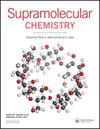对磺托杯[8]芳烃配位钠离子,与小檗碱形成主客体配合物:从晶体结构的视角
IF 2.6
4区 化学
Q3 CHEMISTRY, MULTIDISCIPLINARY
引用次数: 1
摘要
在本文中,我们扩大了大而灵活的大环宿主对磺atocalix[8]芳烃(C8S)在无机和有机阳离子的固体组装中的应用。当钠离子与大环的所有磺酸基配位时,形成三维配位聚合物。C8S采用圆形褶皱环构象,大环分子通过配位与多个钠阳离子相互堆叠。金属-超分子组合的排列为伪六边形。在有机阳离子小檗碱存在的情况下,主客体配合物更有利。大环采用没有实质内腔的构象,其中两个苯磺酸基向分子中心倾斜。一个寄主在大环分子表面的凹槽和缝隙中结合八个小檗碱来访者。C8S是固态小檗碱的合适宿主,这种结晶驱动的主客体络合作用有可能扩大小檗碱的晶型库。图形抽象本文章由计算机程序翻译,如有差异,请以英文原文为准。
P-Sulfonatocalix[8]arene coordinates sodium cations and forms host-guest complex with berberine: insight from crystal structure
ABSTRACT In this paper, we expand the utilisation of large and flexible macrocyclic host p-sulfonatocalix[8]arene (C8S) in building up solid state assemblies with both inorganic and organic cations. Upon coordination of sodium cations to all sulphonate groups of the macrocycle the 3-D coordination polymer is formed. The C8S adopts circular pleated loop conformation and macrocyclic molecules are assembled into stacks stapled by coordination to multiple sodium cations. The arrangement of the metallo-supramolecular assembly is pseudo-hexagonal. In the presence of organic cation berberine, the host-guest complex is favoured. Macrocycle adopts conformation without a substantial internal cavity with two of the benzenesulfonate groups being inclined towards the centre of the molecule. One host binds eight berberine guests in the grooves and clefts of the molecular surface of the macrocycle. C8S is a suitable host for berberine in the solid state, and such crystallisation-driven host-guest complexation has potential in expanding the library of berberine crystal forms. Graphical abstract
求助全文
通过发布文献求助,成功后即可免费获取论文全文。
去求助
来源期刊

Supramolecular Chemistry
化学-化学综合
CiteScore
3.60
自引率
3.00%
发文量
5
审稿时长
2.7 months
期刊介绍:
Supramolecular Chemistry welcomes manuscripts from the fields and sub-disciplines related to supramolecular chemistry and non-covalent interactions. From host-guest chemistry, self-assembly and systems chemistry, through materials chemistry and biochemical systems, we interpret supramolecular chemistry in the broadest possible sense. Interdisciplinary manuscripts are particularly encouraged. Manuscript types include: high priority communications; full papers; reviews, and; Methods papers, techniques tutorials highlighting procedures and technologies that are important to the field. We aim to publish papers in a timely fashion and as soon as a paper has been accepted and typeset it will be published in electronic form on the Latest articles section of the website. The two most important review criteria are that the paper presents high-quality work that fits generally into the broad spectrum of activities in the supramolecular chemistry field. Under normal circumstances, Supramolecular Chemistry does not consider manuscripts that would be more suitable in a highly specialized journal. This includes, but is not limited to, those based mostly or exclusively on topics such as solid state/X-ray structures, computational chemistry, or electrochemistry. .
The two most important review criteria are that the paper presents high-quality work that fits generally into the broad spectrum of activities in the supramolecular chemistry field.
 求助内容:
求助内容: 应助结果提醒方式:
应助结果提醒方式:


